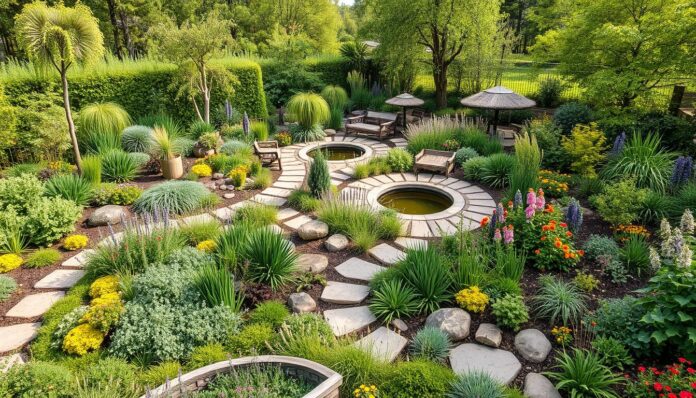The healing power of nature is a secret many know. Imagine walking into a place where plants, paths, and designs heal your body and soul. These spaces are more than gardens; they’re places that connect us with nature.
Permaculture therapy gardens are a new way to heal landscapes. They mix nature’s rules with healing ideas. This creates spaces that help people and the planet.
These gardens understand how nature helps us heal. Studies show they can cut stress by 61% and speed up recovery by 20%. They’re not just pretty; they’re powerful for healing body and mind.
Key Takeaways
- Permaculture therapy gardens combine ecological design with healing principles
- Natural environments can significantly reduce stress and improve health outcomes
- Sustainable healing spaces offer holistic approaches to wellness
- Gardens can be designed to support physical and mental rehabilitation
- Nature-based interventions provide unique therapeutic benefits
Introduction to Permaculture Therapy Gardens
Eco-friendly therapy gardens are a new way to heal and care for the environment. They turn regular gardens into places that help people and nature. This is thanks to the power of therapeutic permaculture design.
These gardens mix health and nature in a special way. They use natural systems and human needs to make spaces that heal. These spaces help both our minds and bodies.
What are Permaculture Therapy Gardens?
Permaculture therapy gardens are special green areas. They use nature and therapy together. They are more than just gardens, they heal people and the land.
- Integrate natural healing processes
- Support mental and physical wellness
- Promote environmental sustainability
- Create regenerative community spaces
Benefits of Therapeutic Gardens
Studies show that gardening is good for our health:
| Health Metric | Improvement Percentage |
|---|---|
| Anxiety and Depression Reduction | 30% |
| Stress Hormone Decrease | Significant |
| Dementia Risk Reduction | 50% |
| Mood and Self-Esteem Enhancement | 40% |
“Permaculture is a philosophy of working with, rather than against nature, of protracted and thoughtful observation rather than protracted and thoughtless labor.” – Bill Mollison
The design of therapeutic permaculture gardens is more than gardening. It creates spaces that help us and our communities. These gardens show how our health is linked to nature.
Principles of Permaculture Design
Permaculture design is a new way to create gardens that help both people and the planet. These gardens are made with care and follow special rules. They make sure both nature and people are happy.
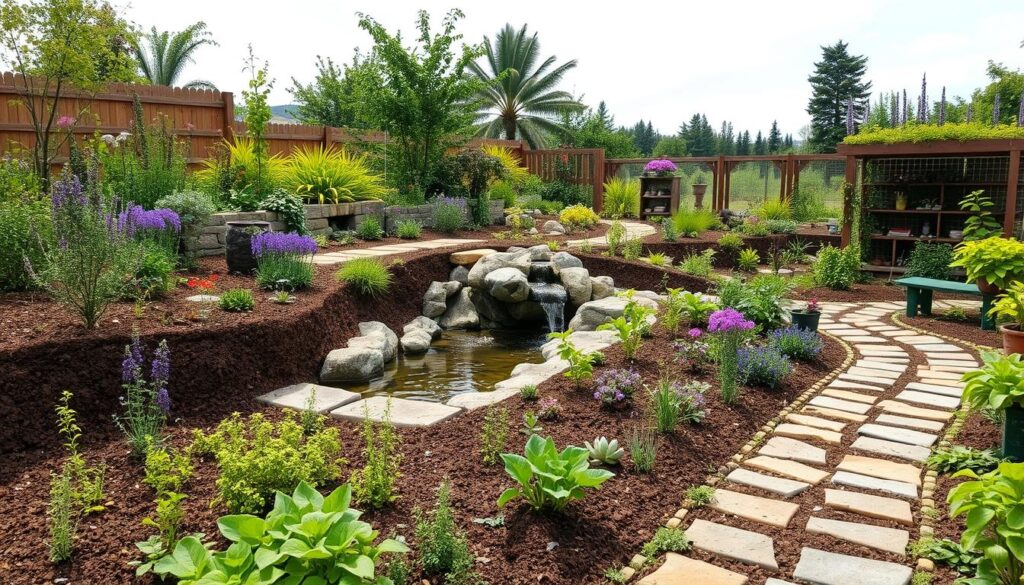
The Ethics of Permaculture
Permaculture has three main rules that guide everything:
- Earth Care: Protecting and nurturing ecological systems
- People Care: Supporting human health and community well-being
- Fair Share: Equitable distribution of resources and opportunities
“In permaculture, we design gardens that heal both the land and the people who interact with them.”
Key Principles in Garden Planning
Good garden design uses a few key strategies:
- Observe and interact with the landscape
- Catch and store energy efficiently
- Obtain a sustainable yield
- Apply self-regulation
- Use renewable resources
| Permaculture Principle | Impact on Regenerative Therapy Landscapes |
|---|---|
| Observation | Understanding site characteristics across seasons |
| Energy Storage | Reducing long-term maintenance requirements |
| Biodiversity | Increasing ecosystem resilience by 30% |
By following these rules, gardens become more than just green spaces. They turn into healing places for both people and the planet.
Benefits of Therapeutic Gardens
Holistic healing gardens are great for our minds, bodies, and the planet. They do more than just grow plants. They create spaces that help us heal and balance nature.
Mental Health Benefits
Therapeutic gardens are amazing for our mental health. Studies show that touching soil can boost serotonin levels. This helps us feel better and strengthens our immune system.
- Reduces stress and anxiety
- Stimulates positive neurochemical responses
- Enhances emotional resilience
The connection between humans and nature represents a powerful healing mechanism.
Physical Health Advantages
Working in permaculture therapy gardens is good for our bodies. It gets us moving and helps us eat better. Picking crops makes us feel good, like our ancestors did.
| Activity | Health Benefit |
|---|---|
| Gardening | Improves muscle strength |
| Crop Harvesting | Stimulates neurochemical reward |
| Soil Interaction | Boosts immune function |
Environmental Impact
Holistic healing gardens are good for our planet. They help local wildlife and improve soil. They show us how to care for the land in a green way.
- Supports local wildlife
- Reduces environmental toxins
- Promotes sustainable practices
Permaculture therapy benefits extend beyond individual healing, creating interconnected ecological networks that support broader environmental restoration.
Plant Selection for Therapy Gardens
Creating mindful permaculture gardens needs careful plant selection. This supports healing and keeps the environment balanced. Sustainable healing spaces come from plants that engage our senses and offer health benefits.
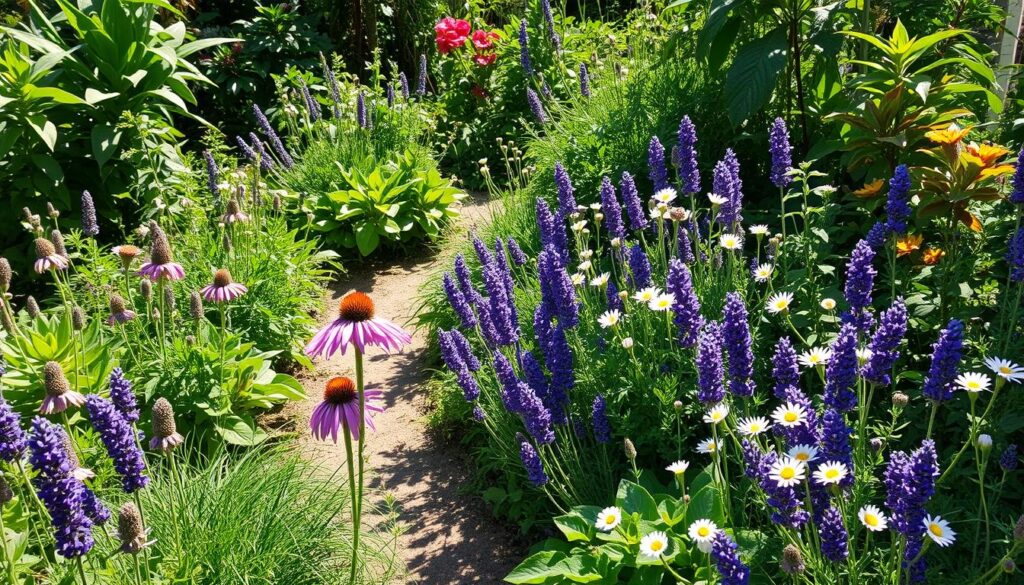
Designing a therapeutic garden means knowing how plants help heal. Medicinal plants have great healing power. They turn gardens into healing places.
Native Plant Species: The Foundation of Healing Gardens
Native plants are key to sustainable healing spaces. They offer many benefits:
- They are strong and resilient
- They help wildlife
- They need less care
- They fit well with local conditions
Edible Plants for Therapeutic Interactions
Adding edible plants makes gardens work in many ways. They feed both body and mind. Here are some plants that help:
| Plant | Therapeutic Benefit | Growing Conditions |
|---|---|---|
| Rosemary | Improves memory | Full sun, well-drained soil |
| Lavender | Reduces stress | Sunny spot, little water |
| Chamomile | Calms | Partial shade, moist soil |
Sensory Plants for Holistic Healing
“Gardens are not just spaces, they are living therapies that engage all our senses.” – Permaculture Design Expert
Sensory plants make healing spaces better by offering different experiences. Studies show they can lower stress and boost thinking skills. This is true for people with brain challenges.
- Textured plants for touch
- Aromatic herbs for smell
- Colorful flowers for sight
By picking plants that heal, we make gardens powerful for wellness and connecting with nature.
Designing the Garden Layout
Creating an eco-friendly therapy garden needs careful planning. Therapeutic permaculture design turns outdoor spaces into healing places. These spaces connect us with nature and work well with the environment.
https://www.youtube.com/watch?v=mgJECzM9Vng&pp=ygUKI3NvY2FsaG9ydA%3D%3D
Permaculture gardens are more than pretty. They are smart designs that follow nature’s patterns. Good garden layouts can really help our mental and physical health.
Zoning for Efficiency
Zoning is key in therapeutic permaculture design. It organizes garden areas by how often they’re used and how much care they need:
- Zone 1: Right by the house, with plants we use a lot and plants that feel good to touch
- Zone 2: A bit further, with veggies and more work to do
- Zone 3: Needs less care, with tough plants that keep going
- Zone 4: Almost wild, with lots of different plants and animals
Incorporating Water Features
Water features are vital in eco-friendly therapy gardens. They make peaceful spots, help local animals, and keep the garden healthy.
| Water Feature | Benefits | Maintenance Level |
|---|---|---|
| Small Pond | Attracts wildlife, provides cooling effect | Moderate |
| Rain Garden | Manages stormwater, supports native plants | Low |
| Birdbath | Supports local bird populations | Easy |
“In permaculture, water is the source of life and connection in any garden design.” – Permaculture Design Expert
By using these ideas, gardeners can make spaces that heal people and the planet.
Elements of Permaculture in Therapy Gardens
Permaculture creates natural therapy gardens that help both our minds and the environment. These gardens are healing spaces for humans and nature.
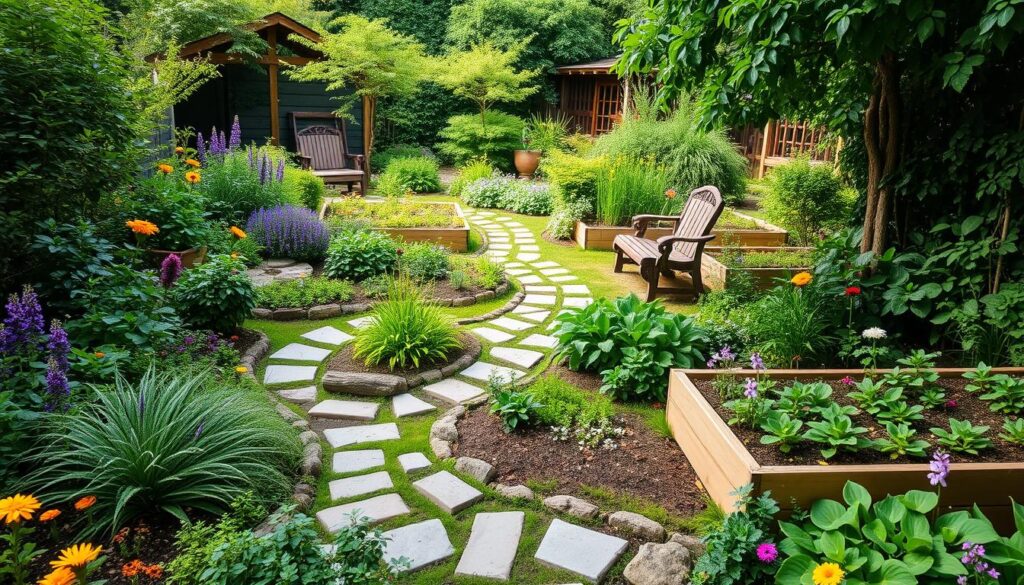
At the heart of permaculture is understanding how plants work together. These gardens are designed to heal, just like nature does.
Companion Planting Strategies
Companion planting is key in therapy gardens. It’s about placing plants in a way that helps each other grow.
- Tomatoes grow well with basil, which repels harmful insects
- Marigolds protect vegetable crops from nematodes
- Beans fix nitrogen in soil, benefiting neighboring plants
Mulch and Compost: Foundations of Soil Health
Healthy soil is the backbone of therapy gardens. Mulch and compost are essential for a sustainable garden.
“In nature, nothing is lost, everything is transformed.” – Permaculture Wisdom
A soil bacterium, Mycobacterium vaccae, can make us feel happier. Working with soil through mulching and composting can boost our mood.
- Organic mulch retains moisture and suppresses weeds
- Compost improves soil structure and nutrient content
- Regular composting reduces waste and supports ecosystem balance
Permaculture turns gardens into healing spaces. They connect us with nature and promote overall well-being.
Engaging Community in Garden Design
Creating holistic healing gardens is more than just growing plants. It’s about bringing people together. These spaces become places of learning, connection, and shared goals. Permaculture therapy benefits everyone, not just individuals.
Community gardens are key for healing and learning together. They can be small or large, offering a variety of activities. This makes them perfect for different needs.
Involving Local Residents
To design a successful community garden, you need to engage the community. Here are some important steps:
- Set up clear volunteer management systems
- Keep communication open and clear
- Make sure everyone shares the same vision
- Ensure everyone has a chance to participate
“Gardens are not just about growing plants, but growing communities.” – Community Design Expert
Educational Workshops
Gardens are great for learning. Schools and youth groups see them as outdoor classrooms. Workshops can cover many topics, like:
- Permaculture design principles
- Understanding ecological systems
- Nutrition and sustainable farming
- Mental wellness through nature
By working together, holistic healing gardens become vibrant places. They help both individuals and communities grow. Permaculture therapy benefits everyone through shared experiences and learning.
Seasonal Considerations in Garden Planning
Creating mindful permaculture gardens means understanding seasonal rhythms. These gardens flourish when gardeners adapt to each season’s unique traits. This makes the gardens dynamic and strong, changing with the year.
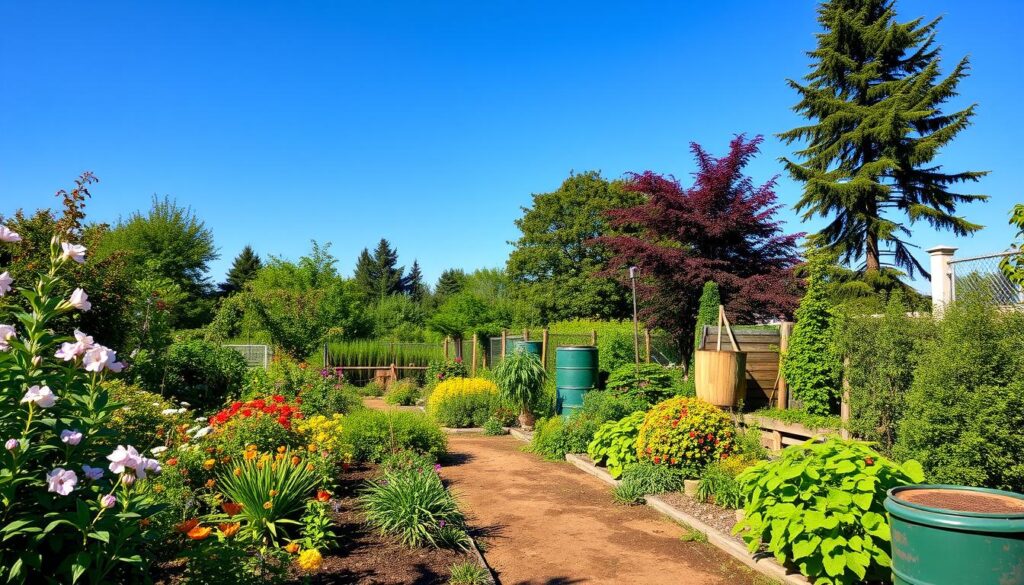
Permaculture design sees gardens as living systems with their own seasonal personalities. By watching and responding to these changes, gardeners make their spaces more adaptable and fruitful.
Strategic Planting Schedules
Planning a seasonal planting schedule is key. It involves knowing about microclimates and how plants interact. Here are some important tips:
- Map out plant zones based on sunlight and temperature variations
- Select plants that complement each other’s growth cycles
- Plan for continuous harvest through strategic crop rotation
- Utilize polyculture techniques to maximize garden productivity
Seasonal Maintenance Tips
“Nature does not hurry, yet everything is accomplished.” – Lao Tzu
Maintenance in mindful permaculture gardens is about minimal effort and working with nature. Important maintenance steps include:
- Implement mulching to protect soil during extreme temperatures
- Practice water conservation through rain harvesting
- Use companion planting to reduce pest management
- Create wildlife-friendly habitats that support year-round ecosystem balance
Regenerative gardening makes gardens more self-sustaining. Studies show that well-designed permaculture systems can thrive for up to 10 years with little human help.
By focusing on seasonal changes, gardeners turn sustainable healing spaces into vibrant, resilient ecosystems. These spaces nourish both people and the environment.
Accessibility in Garden Design
Creating eco-friendly therapy gardens means making them welcoming to all. Therapeutic permaculture design aims to remove barriers. It makes garden spaces open and flexible for everyone.
Accessibility in garden design is more than just tweaks. It’s about building an environment that lets people with different abilities enjoy nature and gardening.
Creating Accessible Pathways
Designing paths for everyone requires careful planning and creative ideas:
- Wide, smooth surfaces for wheelchair navigation
- Gentle slopes with minimal grade changes
- Stable, non-slip materials like compacted gravel or concrete
- Handrails and rest areas for support
“Inclusive design transforms limitations into opportunities for connection with nature.”
Raised Garden Beds for All
Raised garden beds are a big help in therapeutic permaculture design. They offer many benefits for people with mobility issues:
| Bed Height | Accessibility Features | User Benefits |
|---|---|---|
| 18-24 inches | Wheelchair accessible | Reduced bending, easier reach |
| 24-36 inches | Standing height options | Minimal strain for those with back issues |
| Modular designs | Adaptable configurations | Customizable for individual needs |
Studies reveal that 60% of people with disabilities enjoy gardening. Thoughtful eco-friendly therapy gardens can boost participation and healing through nature.
Therapeutic permaculture design is more than just where plants go. It’s about making spaces that support physical, mental, and emotional health for all.
Incorporating Wildlife into Therapy Gardens
Natural therapy gardens are more than pretty spaces. They support both human health and local wildlife. These gardens are essential habitats for pollinators and birds, making them better for therapy.
To design a wildlife-friendly garden, you need a plan. It’s about creating a living space that boosts mental and physical health. It also helps protect biodiversity.
Attracting Pollinators
Pollinators are key to these gardens. By using the right strategies, you can make your garden a welcoming place for bees, butterflies, and more.
- Plant native flowering species
- Create diverse nectar sources
- Avoid chemical pesticides
- Provide water sources
Bird-Friendly Features
Therapy gardens can also be bird sanctuaries. With the right design, you can attract birds and offer them a safe place. This also enriches the garden experience for visitors.
| Garden Feature | Bird Attraction Benefits |
|---|---|
| Native Berry Bushes | Food source and shelter |
| Bird Baths | Hydration and bathing |
| Nesting Boxes | Safe breeding spaces |
| Varied Vegetation Layers | Multiple habitat zones |
“A garden is a complex ecosystem that connects humans with nature’s intricate web of life.” – Ecological Design Expert
By adding wildlife-friendly features, therapy gardens become dynamic healing environments. They support the well-being of both humans and local wildlife.
Case Studies of Successful Therapy Gardens
Holistic healing gardens are changing lives across the United States. They show how nature can heal both mind and body. These gardens are a key part of permaculture therapy, showing the deep bond between nature and healing.
Studies have found big benefits from permaculture therapy gardens. Looking at successful gardens, we see how they can change lives:
- Forest Farm Peace Garden in Oregon provides groundbreaking mental health support
- Urban therapy gardens in San Francisco address community wellness
- Rehabilitation centers integrating gardening programs for holistic healing
Notable Permaculture Therapy Gardens in the U.S.
Here are some examples of how these gardens make a big difference:
- Forest Farm Peace Garden: Offers free two-day training focused on permaculture and mental health
- Community gardens in Seattle providing social connection and emotional support
- Veterans rehabilitation programs using holistic healing gardens
“Nature is not just a backdrop, but an active participant in the healing process.” – Dr. Rachel Green, Ecotherapy Specialist
Testimonials from Users
People who use permaculture therapy gardens have seen big changes:
- 30% reduction in anxiety and depression symptoms
- Significant decrease in stress hormone levels
- 50% lower risk of dementia in older adults
- 40% improvement in mood and self-esteem
These gardens are more than just green spaces. They offer a full healing approach. They mix social interaction, physical activity, and nature connection.
Challenges in Establishing Therapy Gardens
Creating mindful permaculture gardens is not easy. They need careful planning and creative solutions. This turns garden dreams into real healing spaces.
Overcoming Common Obstacles
Starting therapeutic gardens comes with its own set of challenges. Some major hurdles include:
- Soil quality and preparation
- Climate adaptation strategies
- Regulatory compliance
- Community engagement
“Successful gardens emerge from understanding natural limitations and creatively working within them.”
Sustainability Concerns
Keeping healing spaces sustainable is a big task. It involves many important steps:
- Water conservation techniques
- Soil health maintenance
- Climate resilience planning
- Resource-efficient design
Studies show that having a plan is key to keeping gardens going. Strategic planning helps overcome obstacles. This keeps these spaces lively and useful.
For example, programs for veterans show the value of a structured approach. They tackle issues like getting to the garden and teaching people how to care for it. This way, permaculture gardens can truly heal and transform lives.
Future Trends in Permaculture Therapy Gardens
The world of eco-friendly therapy gardens is changing fast. New ideas in therapeutic permaculture design mix technology with nature. Mental health experts and landscape architects see the power of gardens in healing and improving mental health.
New trends are moving towards gardens that can change and adapt. Now, we can track plant health and soil conditions with digital tools. This lets us design gardens that can adjust to new situations quickly.
Getting people involved in garden projects is also key. Cities are starting garden projects that help both mental health and grow food. Studies show that gardens with community help build stronger connections and healthier ecosystems.
As the climate changes, permaculture gardens are becoming places to test new ideas. Designers are trying out different plants, layering, and water-saving methods. These ideas help gardens stay useful even when the weather changes.
Innovations in Garden Design
New designs focus on creating spaces that engage all senses. Techniques like vertical gardening and managing microclimates are changing how we garden. These methods make gardens more interactive and interesting.
The Growing Interest in Mental Health Initiatives
More mental health professionals see green spaces as important for healing. Permaculture gardens offer a place for physical activity, socializing, and connecting with nature. They provide a holistic approach to health.

